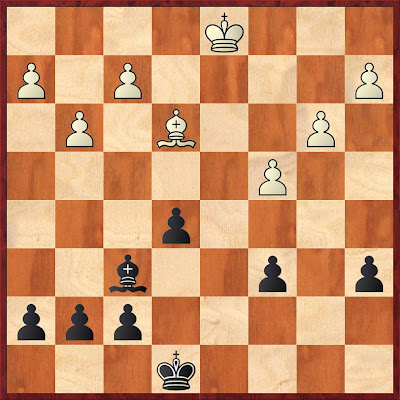
Edmonton International (5), 21.08.2008
1.e4 c5
2.c3 Nf6
3.e5 Nd5
4.g3 d6
5.exd6 e6
6.Bg2 Bxd6
7.Ne2 0–0
8.0–0 Nc6

Hurray! I did what my file says I'm supposed to.
9.Na3 a6?
Probably a wasted tempo? Brynell -Cramling 1993 0–1 went 9...Be7 10.d3 e5 11.Nc4 Be6 12.a4 Qd7 13.Bd2 Rad8 14.b3 f5 15.Ra2 Bf6
10.Nc4 Be7
11.d4 cxd4
12.Nxd4
12.cxd4 Bf6 I figured this was a fine isolated pawn position for me. My knight is already on d5, his dark bishop doesn't have any obvious squares, and his Ne2 is placed a little strangely.
12...Nxd4 13.Qxd4
13.cxd4 It would be insane, of course, to trade a pair of minor pieces and then accept an isolated pawn.
13...Bf6

14.Qg4 [14.Qd3? Nxc3]
14...Qc7
15.Ne3 I don't want to take this knight at all, because I think both his knight and bishop want to be on e3, but unfortunately I don't have a good retreat.
15...Nxe3
16.Bxe3 Bd7
17.Rfd1
17.Qb4-- I was scared of this move in the game. It's like I'm almost equal, except that his bishops have unpleasant pressure against my queenside pawns. 17...Bc6 18.Bb6 Qc8 19.Rfd1 Bxg2 20.Kxg2 Qc6+ 21.Kg1 still, just slightly unpleasant.
17...Bc6
18.Qc4 Rfd8
19.Bxc6 Qxc6
I don't want to weaken my pawns without trading queens, since they will be on light squares and consequently are much more vunerable with queens on.
20.Qxc6 bxc6
21.Kf1 Kf8
22.Ke2 Ke8
23.b3 23...Rd5
23...Rd5
Not 23...Bxc3? I'm not winning a pawn and I'm just activating his rook. 24.Rxd8+ Rxd8 25.Rc1 Bb4 26.Rxc6]
24.Rac1 [24.c4? Rh5]
24...Rad8
25.c4 Rxd1
26.Rxd1 Rxd1
27.Kxd1 e5
I need to push the pawns on the side where I have an extra. If I just sit around, he will make a queenside passed pawn and beat me.
28.Kc2 Be7
29.Kd3 Kd7
30.c5 f5
31.b4 g5
32.a4 h5
33.Kc4 f4
34.Bd2
34...fxg3
Beastie likes 34...Ke6!? 35.h3 (35.b5?! axb5+ 36.axb5 cxb5+ 37.Kxb5 Kd5 38.c6 Bd8 39.Bb4 e4 40.gxf4 gxf4 41.Bc5=) 35...g4 36.hxg4 hxg4 37.gxf4 Bh4 38.f5+ (38.fxe5 Bxf2-/+) 38...Kxf5 39.Be3=
35.fxg3 g4
36.b5 cxb5+
37.axb5 axb5+
38.Kxb5 h4 [38...Bd8]
39.c6+ Kc7 not Kc8 because I want the white bishop to have to come to a5
40.Ba5+ Kc8 41.Bb4 Bg5 42.Bd6 [42.Kc4]
I really can't quite describe what happened here. I guess I was tired. Back when I played 42...h3, I saw this great idea that I could sack the e5 pawn to play Be3-g1xh2. Then he has to put his bishop on f2, and it's a draw. If his king ever goes over to help, I can take the c pawn.
I had spent some time making sure of everything and I was proud of myself. But then I started second-guessing ... somehow I talked myself into believing that I would be zugzwanged and my king would have to move out from c8, allowing the pawn to queen. And I did something pretty uncharacteristic-- I didn't double check the "losing" variation, I just gave up and got upset. Which is a shame because the draw is pretty.
44...Bf2 [44...Bg1 45.Bd4 Bxh2 46.Bf2 Kc7 47.Kd5 Kc8 48.Kd6 Kd8 
analysis diagram
49.c7+ Kc8 50.Kc6 Bg1 51.Bxg1 h2 52.Bxh2 stalemate]
45.Kd5 Kd8?? oh my god [45...Bg1]
46.Ke4 Bg1 47.Kf5 1–0



No comments:
Post a Comment